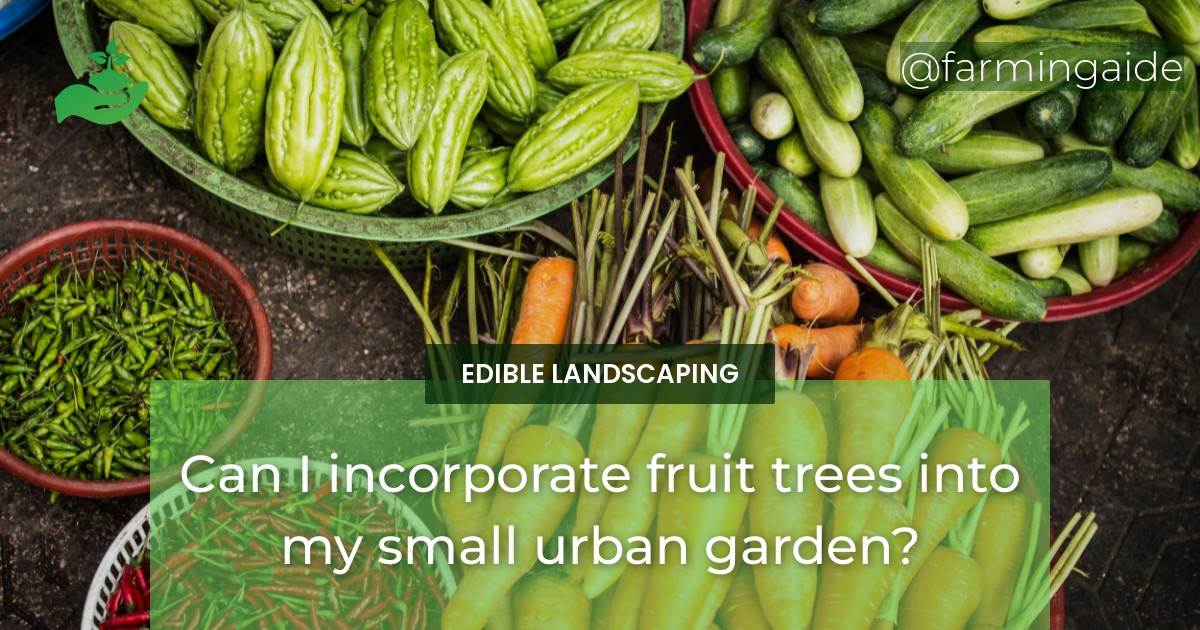Yes, incorporating fruit trees into a small urban garden is possible. With the right planning and techniques, you can grow fruit trees and enjoy fresh fruits from your garden. Urban fruit trees are perfect for small gardens, rooftops, and balconies where space is limited. They not only add beauty to your landscape but also provide you with fresh fruits throughout the year.
Dwarf and Compact Varieties for Small Urban Gardens
What are Dwarf and Compact Fruit Trees?
Dwarf and compact fruit trees are smaller in size and grow less than their standard counterparts. They are perfect for small urban gardens as they take up less space and are easier to maintain. Dwarf fruit trees typically grow up to 8-10 feet tall and wide, while compact fruit trees grow up to 6-8 feet tall and wide.
Benefits of Dwarf and Compact Fruit Trees
- Take up less space
- Easier to maintain and harvest
- Produce fruits earlier than standard trees
- More resistant to diseases and pests
- Can be grown in containers
Examples of Dwarf and Compact Fruit Trees
- Dwarf apple trees: Honeycrisp, Gala, Granny Smith
- Compact citrus trees: Meyer lemon, Calamondin, Blood Orange
- Dwarf peach trees: Bonanza, Pixie, Elberta
- Compact cherry trees: Compact Stella, North Star, Surefire
- Dwarf pear trees: Bartlett, Comice, Bosc
Espalier Training for Fruit Trees in Small Urban Gardens
What is Espalier Training?
Espalier training is a horticultural technique that involves training fruit trees to grow in a flat two-dimensional plane against a wall or a trellis. Espalier training is perfect for small urban gardens as it allows you to grow fruit trees in limited space while also adding an aesthetic appeal to your garden.
Benefits of Espalier Training for Fruit Trees in Small Urban Gardens
- Allows you to grow fruit trees in limited space
- Adds an aesthetic appeal to your garden
- Easier to maintain and harvest
- Increases fruit production
- Protects the tree from pests and diseases
How to Espalier Train Fruit Trees in Small Urban Gardens
- Select a fruit tree that is suitable for espalier training
- Choose a wall or a trellis to train the tree against
- Prune the tree to a desired shape
- Tie the branches to the wall or trellis
- Regularly prune and train the tree as it grows
ALSO READ
Proper Spacing for Fruit Trees in Small Urban Gardens
Importance of Proper Spacing for Fruit Trees
Proper spacing is essential for the healthy growth of fruit trees. When trees are planted too close, they compete for nutrients, water, and sunlight. This can result in stunted growth, poor fruit quality, and increased risk of pest and disease infestation.
Factors to Consider When Spacing Fruit Trees in Small Urban Gardens
- The size of the tree at maturity
- The type of soil
- The amount of sunlight the area receives
- The presence of other trees or plants in the area
Recommended Spacing for Fruit Trees in Small Urban Gardens
- Dwarf and compact fruit trees: 6-10 feet apart
- Standard fruit trees: 15-20 feet apart
Pruning Fruit Trees in Small Urban Gardens
Why is Pruning Important for Fruit Trees in Small Urban Gardens?
Pruning is essential for fruit trees as it helps to maintain their shape, remove dead or diseased branches, and improve fruit production. Pruning also helps to control the size of the tree, making it easier to maintain in a small urban garden.
When and How to Prune Fruit Trees in Small Urban Gardens
- Prune fruit trees in late winter or early spring before new growth appears
- Remove dead, damaged, or diseased branches
- Remove any branches that cross or rub against each other
- Prune to maintain the desired shape and size
Tools Required for Pruning Fruit Trees in Small Urban Gardens
- Pruning shears
- Loppers
- Hand saw
- Pole pruner
ALSO READ
Can Vertical Gardens Accommodate Fruit Trees in Urban Settings?
Yes, starting seeds for vertical gardens can accommodate fruit trees in urban settings. With proper planning and support structures, vertical gardens can provide the necessary space and conditions for fruit trees to thrive in urban environments. This innovative approach allows for increased greenery and food production within limited space.
Other Considerations for Incorporating Fruit Trees into Small Urban Gardens
Soil Requirements for Fruit Trees in Small Urban Gardens
Most fruit trees prefer well-drained soil that is rich in organic matter. It is best to test the soil before planting to ensure that it is suitable for the type of fruit tree you want to grow. If the soil is too sandy or too clayey, you can amend it by adding compost or other organic matter.
Sunlight Needs for Fruit Trees in Small Urban Gardens
Fruit trees require at least 6 hours of direct sunlight per day to grow and produce fruits. When planting fruit trees in a small urban garden, it is essential to choose a location that receives adequate sunlight throughout the day.
Watering and Fertilizing Fruit Trees in Small Urban Gardens
Fruit trees require regular watering, especially during the growing season. It is best to water deeply and infrequently rather than shallowly and frequently. Fertilizing fruit trees with a balanced fertilizer in early spring can help promote healthy growth and fruit production.
Pests and Diseases to Watch Out for in Fruit Trees in Small Urban Gardens
- Aphids
- Codling moths
- Fruit flies
- Fire blight
- Apple scab
Harvesting and Storing Fruit from Trees in Small Urban Gardens
- Harvest fruit when it is fully ripe
- Store fruit in a cool, dry place
- Use fruit within a few days of harvesting
- Preserve fruit by canning, freezing, or drying
RELATED ARTICLES:


